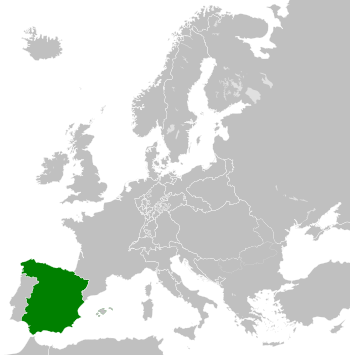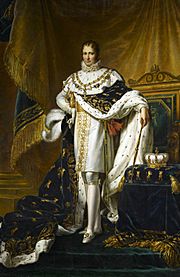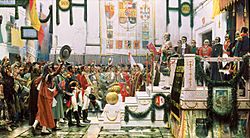Spain under Joseph Bonaparte facts for kids
Quick facts for kids
Kingdom of Spain
|
|||||||||
|---|---|---|---|---|---|---|---|---|---|
| 1808–1813 | |||||||||
|
Motto: Plus Ultra
"Further Beyond" |
|||||||||

De jure borders of the Kingdom of Spain in 1812
|
|||||||||
| Status | Client state of the French Empire | ||||||||
| Capital | Madrid | ||||||||
| Common languages | Spanish and French | ||||||||
| Religion | Catholicism | ||||||||
| Demonym(s) | Spaniard, Spanish | ||||||||
| Government | Absolute monarchy | ||||||||
| King | |||||||||
|
• 1808–1813
|
Jose I | ||||||||
| Regent | |||||||||
|
• 1808
|
Joachim Murat | ||||||||
| First Secretary of State | |||||||||
|
• 1808–1813
|
Mariano Luis de Urquijo | ||||||||
|
• 1813
|
Juan O'Donoju O'Ryan | ||||||||
|
• 1813
|
Fernando de Laserna | ||||||||
| Legislature | Cortes Generales | ||||||||
| Historical era | Napoleonic Wars | ||||||||
| 6 May 1808 | |||||||||
| 8 July 1808 | |||||||||
| 21 June 1813 | |||||||||
| 11 December 1813 | |||||||||
| Currency | Spanish real | ||||||||
| ISO 3166 code | ES | ||||||||
|
|||||||||
| Today part of | Spain | ||||||||
Napoleonic Spain was the part of Spain that supported Joseph I between 1808 and 1813. This happened during the Peninsular War, when French forces partly took over the country. During this time, Spain was seen as a "client state" of the First French Empire. A client state is like a smaller country that is controlled by a more powerful one.
The rest of Spain did not want French rule. They stayed loyal to their king, Ferdinand VII. This part of Spain teamed up with Britain and Portugal. Their goal was to force Napoleon's armies out of Spain. The war was tough, with many ups and downs. But from 1812 to 1813, the Allied forces won key battles. These victories at Salamanca and Vitoria led to the defeat of Joseph Bonaparte's rule. Napoleon's troops were then kicked out of Spain. The Treaty of Valençay officially made Ferdinand VII the rightful King of Spain again.
Contents
How the War Started: Spain and France
Kings Change Hands: Ferdinand VII and Charles IV
Spain had been friends with France since 1796. They fought together against Britain. But after their navies lost to Britain at the Battle of Trafalgar in 1805, things changed. Spain started to have doubts about their alliance.
In 1806, Spain even thought about attacking France. But Napoleon's army quickly defeated Prussia. This made Spain back down. Spain was also unhappy about losing its ships at Trafalgar. They also disliked being forced to join Napoleon's trade system.
Still, Spain and France agreed to divide Portugal. Portugal was a long-time friend of Britain. Napoleon knew Spain's economy and government were weak. He thought Spain was not a strong ally anymore. He sent French troops into Spain. He said they were there to get ready to invade Portugal. But more and more French troops kept coming into Spain. They did not seem to be moving towards Portugal.
Spanish people were very unhappy about so many French soldiers. This led to a protest called the Tumult of Aranjuez. Supporters of Ferdinand, the king's son, led this protest. In March 1808, Charles IV of Spain gave up his throne. His main minister, Manuel de Godoy, was also removed. Ferdinand was then declared the new king. He went to Madrid, ready to rule.
Napoleon Bonaparte called Ferdinand to Bayonne, France. Ferdinand thought Napoleon would approve him as king. Napoleon also called Charles IV, who arrived separately. Napoleon pushed Ferdinand to give up his throne to his father. Charles IV then gave up his throne to Napoleon. He did not want his son to be king. Napoleon then made his brother, Joseph, the new king of Spain. These official changes were meant to make the new king seem legitimate.
Joseph Bonaparte Becomes King
Charles IV hoped Napoleon would help him get his throne back. By this time, Napoleon had 100,000 soldiers in Spain. But Napoleon refused to help Charles. He also did not accept Ferdinand VII as the new king. Instead, he forced both Charles and Ferdinand to give the crown to his brother, Joseph Bonaparte.
Meanwhile, the French army leader in Spain, Marshal Joachim Murat, pushed for Manuel de Godoy to be freed. Godoy was the former Spanish Prime Minister. He had invited the French into Spain, which led to the protest in Aranjuez. The Spanish government did not stand up to Murat. This made people very angry. On May 2, 1808, the younger son of Charles IV, Infante Francisco de Paula, left Spain for France. This caused a big rebellion in the streets of Madrid.
The Council of Castile was the main government body in Spain. It was now controlled by Napoleon. But people were so angry at French rule that the Council quickly lost power. This happened everywhere except in cities directly held by the French. To fight the French, old regional governments came back. Examples include the Cortes of Aragon and the Board of Asturias. In other places, new groups called juntas (councils) were formed. They filled the power gap and led the fight against the French.
These local juntas started working together. Then, regional juntas were formed to watch over the local ones. Finally, on September 25, 1808, one big Supreme Central Junta was created. It was in Aranjuez. This group acted as the main resistance government for all of Spain.
French Control and Resistance
Murat made a plan to conquer Spain. He sent two large armies to attack areas that supported Ferdinand. One army secured the road between Madrid and Vitoria. It also surrounded cities like Zaragoza, Girona, and Valencia. The other army went south to Andalusia. It attacked Córdoba.
General Dupont was supposed to go to Cádiz. But he was told to march back to Madrid instead. General Castaños defeated him at the Battle of Bailén on July 22, 1808. This victory encouraged other countries in Europe to resist the French. After the battle, King Joseph left Madrid. He went to Vitoria for safety.
In the fall of 1808, Napoleon himself came to Spain. He entered Madrid on December 2. He put Joseph I back in charge of the capital. Meanwhile, a British army entered Spain from Portugal. But they had to retreat to Galicia. In early 1810, the French army got close to Lisbon. But they could not get past the strong defenses called the Lines of Torres Vedras.
King Joseph I's Rule in Spain


Joseph Bonaparte's government was based on a law called the Bayonne Statute. When Ferdinand VII left Bayonne in May 1808, he asked all Spanish groups to work with the French. On June 15, 1808, Joseph, Napoleon's older brother, became King. The Council of Castile met in Bayonne. Only 65 of its 150 members attended. The group approved Joseph Bonaparte becoming king. They also accepted a new set of laws written by Napoleon. Most people there did not see a problem with working with the new king. After all, a foreign family had ruled Spain before. The House of Bourbon came from France in the 1700s. This happened after the last Spanish Habsburg king, Charles II, died without children.
Napoleon and Joseph both did not realize how much people would resist. Napoleon had successfully made Joseph king of Naples in 1806. He also put other family members in charge of Holland and Westphalia. So, they were surprised that Spain became such a big problem.
Joseph Bonaparte announced the Bayonne Statute on July 7, 1808. This was a set of laws given by the king, not made by a parliament. It aimed to make reforms, like Napoleon wanted. But it also tried to fit Spanish culture. This was to get support from important people. It said that the Catholic religion was the only official religion. It did not allow other religions. It did not clearly separate government powers. But it did say that judges should be independent. The King and his ministers held the executive power.
The courts were made up of clergy, nobles, and common people. The King had a lot of power over making laws. He only had to call Parliament every three years. The law did not clearly say that all citizens were equal. But it did imply it by making taxes equal. It also ended special privileges. It gave equal rights to Spanish and American citizens. The law also allowed free industry and trade. It ended trade privileges and internal customs taxes.
The Constitution created the Cortes Generales. This was an advisory group. It had a Senate with royal family members and 24 members chosen by the king. It also had a law-making assembly. This assembly had representatives from the nobles and clergy. The Constitution created a strong government. It included some good ideas, like ending torture. But it kept the Inquisition, a religious court.
The Spanish uprising led to the Battle of Bailén in July 1808. The French lost this battle. Joseph and the French leaders fled Madrid. They left much of Spain.
While in Vitoria, Joseph Bonaparte worked to set up government groups. He created an advisory Council of State. The king chose a government. Its leaders were smart and wanted to make reforms. The Inquisition was ended. The Council of Castile was also ended. It was accused of being anti-French. Joseph also ended feudal rights. He reduced religious groups and removed internal customs fees.
During this time, trade and farming were made more open. A stock exchange was created in Madrid. The State Council divided the land into 38 provinces.
As people rebelled against Joseph Bonaparte, many who first worked with him left. But many Spanish people, called afrancesados, stayed and helped his government. This made the Spanish war of independence partly a civil war. The afrancesados believed in modernizing Spain. They saw Joseph Bonaparte's arrival as a chance to do this. Many had worked in government before, like François Cabarrus and Mariano Luis de Urquijo. There were also writers, scholars, and musicians among them.
Throughout the war, Joseph Bonaparte tried to rule Spain fully. He wanted some freedom from his brother Napoleon. Many afrancesados thought that working with the new king was the only way to keep Spain independent. They believed that more resistance would mean more French control. But the opposite happened. Even though Joseph I tried to set up a modern government, the constant war made the French army leaders more powerful. This left little room for civil leaders to act.
The French army lost many battles. This forced Joseph to leave Madrid three times. The first time was in July 1808, after the Battle of Bailén. The French took Madrid back in November. The second time was from August to November 1812. The British and Portuguese armies occupied Madrid then. The king left Madrid for the last time in May 1813. He left Spain in June 1813, after the Battle of Vitoria. This ended his attempt at ruling Spain. Most of Joseph's supporters (about 10,000 to 12,000 people) fled to France. Their property was taken away. Joseph gave up his throne.
What Happened to Joseph Bonaparte?
Joseph spent time in France. Then he went to the United States. He lived there from 1817 to 1832. He sold the jewels he took from Spain. In New York City and Philadelphia, his house became a meeting place for French people living abroad. He later married an American woman.
Joseph Bonaparte returned to Europe. He died in Florence, Italy. He was buried in the Les Invalides building in Paris.
Spain's Other Government: The Cortes of Cádiz

In 1810, the Cortes of Cádiz was formed. It acted as a government in exile. The Cortes Generales had to move from Seville to Cádiz. This was to escape the advancing French army. The French tried to surround Cádiz from February 1810 to August 1812. But the city never gave up. The members of the Cortes broke up and gave their power to a Council of Regency. This council called for the Cortes to meet in Cadiz. The Cortes had representatives from different social groups. But they could not hold elections in Spain or its American colonies. So, the assembly changed to represent different areas instead.
The Constitution of Cádiz
The Cortes started their meetings in September 1810 on the Isla de León. There were 97 members. 47 of them were stand-ins from Cádiz residents. They approved a law saying they represented the Spanish nation. They declared themselves a legal court where the nation's power lay.
The constitution they wrote did not last long. On March 24, 1814, Ferdinand VII returned to Spain. Six weeks later, he ended the constitution. He also had all monuments to it torn down.
The Allies Win the War
In March 1813, Joseph had to leave Madrid. The Anglo-Spanish army was threatening him. The Allied attack grew stronger. It ended with the Battle of Vitoria in June. French troops were finally forced out of Spain. This happened after the Siege of San Sebastián ended in September 1813. This meant the French could not come back. In December 1813, the Treaty of Valençay was signed. It brought Ferdinand VII back to the throne.
See also
 In Spanish: España napoleónica para niños
In Spanish: España napoleónica para niños
- History of Spain
- Peninsular War
- Chronology of events of the Peninsular War
- Napoleonic Wars
- Afrancesados



